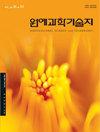Comparative Analysis of Pigment Biosynthesis Gene Expression Related to Enhanced Skin Color in ‘Mishima’ Apples during Fruit Development
IF 0.8
4区 农林科学
Q3 HORTICULTURE
Korean Journal of Horticultural Science & Technology
Pub Date : 2021-06-01
DOI:10.7235/HORT.20210034
引用次数: 1
Abstract
In apple (Malus domestica), red coloration is an attractive trait for consumers. The color of fruit skin is determined by the distribution of carotenoids and anthocyanins in the skin tissue. ‘Fuji’ apples have red stripes over a yellow-green background, and ‘Mishima’, a ‘Fuji’ bud sport variety, has superior coloration compared to its parent. To investigate the genetic mechanism underlying the enhanced pigmentation in ‘Mishima’ fruit skin, we characterized the expression of pigment biosynthesis genes in ‘Fuji’ and ‘Mishima’ apples during fruit development. CIELAB data showed lower L* (relative lightness) and higher a*/b* ratio (relative redness) values in ‘Mishima’ apples, suggesting increased red pigmentation, which correlated with the levels of pigment biosynthesis gene expression. In ‘Mishima’, two carotenoid biosynthesis genes (MdZISO and MdLCY-ε) were upregulated at many stages of fruit development. Furthermore, enhanced red pigmentation was resulted from higher expression levels of three anthocyanin regulatory (MdMYB10, MdWD40, and MdGST) and three structural (MdCHS, MdCHI, and MdF3’H) genes, suggesting their positive interaction. These data further our understanding of the molecular basis of the enhanced skin color of ‘Fuji’ apple varieties. Additional key words: anthocyanin, bud sport, carotenoid, Malus domestica, skin coloration三岛苹果果实发育过程中与增色相关色素生物合成基因表达的比较分析
在苹果(Malus domestica)中,红色对消费者来说是一个有吸引力的特征。水果皮的颜色是由皮肤组织中类胡萝卜素和花青素的分布决定的“富士”苹果在黄绿色背景上有红色条纹,“三岛”是一种“富士”花蕾运动品种,与亲本相比,颜色优越。为了研究‘三岛’果皮色素沉着增强的遗传机制,我们对‘富士’和‘三岛”苹果在果实发育过程中色素生物合成基因的表达进行了表征。CIELAB数据显示,“三岛”苹果的L*(相对亮度)较低,a*/b*比值(相对发红)较高,这表明红色色素沉着增加,这与色素生物合成基因表达水平相关。在“三岛”中,两个类胡萝卜素生物合成基因(MdZISO和MdLCY-ε)在果实发育的许多阶段都被上调。此外,三个花青素调节基因(MdMYB10、MdWD40和MdGST)和三个结构基因(MdCHS、MdCHI和MdF3'H)的高表达水平导致了红色色素沉着的增强,这表明它们之间存在积极的相互作用。这些数据进一步加深了我们对“富士”苹果品种肤色增强的分子基础的理解。附加关键词:花青素,花蕾运动,类胡萝卜素,家苹果,皮肤着色
本文章由计算机程序翻译,如有差异,请以英文原文为准。
求助全文
约1分钟内获得全文
求助全文
来源期刊
CiteScore
2.00
自引率
0.00%
发文量
0
审稿时长
1 months
期刊介绍:
Horticultural Science and Technology (abbr. Hortic. Sci. Technol., herein ‘HST’; ISSN, 1226-8763), one of the two official journals of the Korean Society for Horticultural Science (KSHS), was launched in 1998 to provides scientific and professional publication on technology and sciences of horticultural area. As an international journal, HST is published in English and Korean, bimonthly on the last day of even number months, and indexed in ‘SCIE’, ‘SCOPUS’ and ‘CABI’. The HST is devoted for the publication of technical and academic papers and review articles on such arears as cultivation physiology, protected horticulture, postharvest technology, genetics and breeding, tissue culture and biotechnology, and other related to vegetables, fruit, ornamental, and herbal plants.

 求助内容:
求助内容: 应助结果提醒方式:
应助结果提醒方式:


